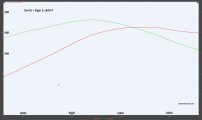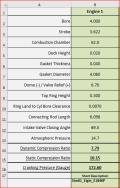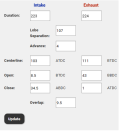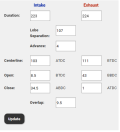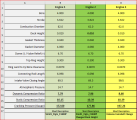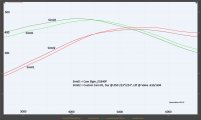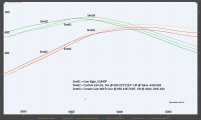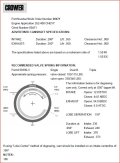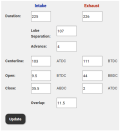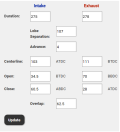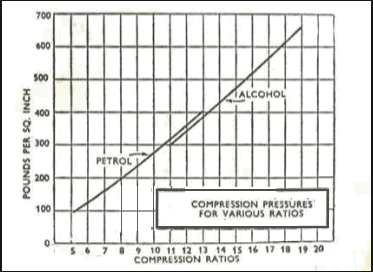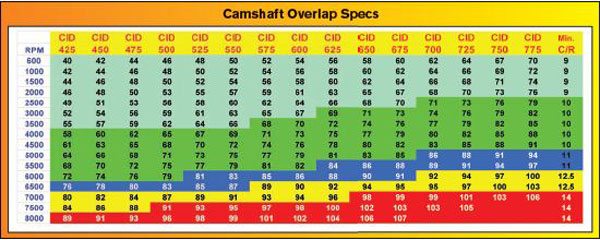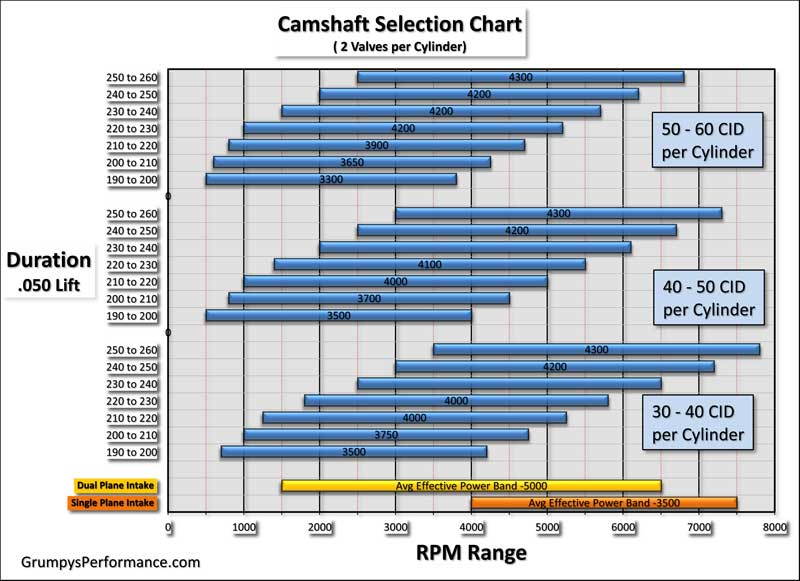Interested to see what a simulation would show.
Rick as requested.
Dynomation 6 Input Variables
Bore & Stroke: 4.00 X 3.622 (LQ4)
Displacement: cubic inches: 364
Rod Length: 6.098
Heads Make/Model with flow numbers: Flow (CFM) at several lift points.
Combustion Chamber Size in CC’s: 62
Dome Volume: For a domed piston use a (-) negative number. +6.7 (dished)
Valve Relief Volume: For a piston with valve reliefs or dish, use a (+) positive number. see above
Deck Clearance: (Piston to Block Surface) - not measured... assume 0.00"??
Head Gasket Bore: 4.06
Head Gasket Thickness: .040"
Valve Sizes Intake/Exhaust: 2.00/ 1.55
Intake Manifold Type: [Single or Dual Plane] - Dual
Manufacture/Model #: Edelbrock - RPM LS 71187
Carburetor Size or EFI (CFM): 770, vac secondary Holley
Blower/Turbo Make/Model: N/A
Belt Ratio: N/A
Header Tube Diameter: 1-5/8", 1-3/4", 1-7/8", 2.0" - 1 -7/8"
Cam Part Number: Elgin E-1840-P
Cam Specs: Need all 8 valve timing events at seat-to-seat and at 0.050” plus lobe lift or valve lift OR post Cam Card OR give me what you have.
0.006" and 0.050"
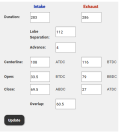
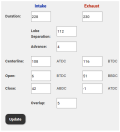
Rocker Ratio - Intake/Exhaust: 1.7
Cam Installed per Cam Card, or Retarded or Advanced: as per above, installed as per card with ground in 4 degree advance
Fuel Used: Gasoline (Octane ?), Methanol, Ethanol, E85 ..... gas 89 (mid grade where I live 87,89,91)
Rick as requested.
Dynomation 6 Input Variables
Bore & Stroke: 4.00 X 3.622 (LQ4)
Displacement: cubic inches: 364
Rod Length: 6.098
Heads Make/Model with flow numbers: Flow (CFM) at several lift points.
| 0.050 | 31.1 | 24.7 |
| 0.100 | 65.4 | 52.6 |
| 0.200 | 142.2 | 98.1 |
| 0.300 | 193.5 | 133.5 |
| 0.400 | 230.2 | 160.1 |
| 0.500 | 243.4 | 175.5 |
| 0.600 | 248.1 | 185.8 |
| 0.650 | 249.3 | 188.2 |
| 0.700 | 250.2 | 191.1 |
Dome Volume: For a domed piston use a (-) negative number. +6.7 (dished)
Valve Relief Volume: For a piston with valve reliefs or dish, use a (+) positive number. see above
Deck Clearance: (Piston to Block Surface) - not measured... assume 0.00"??
Head Gasket Bore: 4.06
Head Gasket Thickness: .040"
Valve Sizes Intake/Exhaust: 2.00/ 1.55
Intake Manifold Type: [Single or Dual Plane] - Dual
Manufacture/Model #: Edelbrock - RPM LS 71187
Carburetor Size or EFI (CFM): 770, vac secondary Holley
Blower/Turbo Make/Model: N/A
Belt Ratio: N/A
Header Tube Diameter: 1-5/8", 1-3/4", 1-7/8", 2.0" - 1 -7/8"
Cam Part Number: Elgin E-1840-P
Cam Specs: Need all 8 valve timing events at seat-to-seat and at 0.050” plus lobe lift or valve lift OR post Cam Card OR give me what you have.
0.006" and 0.050"


Rocker Ratio - Intake/Exhaust: 1.7
Cam Installed per Cam Card, or Retarded or Advanced: as per above, installed as per card with ground in 4 degree advance
Fuel Used: Gasoline (Octane ?), Methanol, Ethanol, E85 ..... gas 89 (mid grade where I live 87,89,91)

